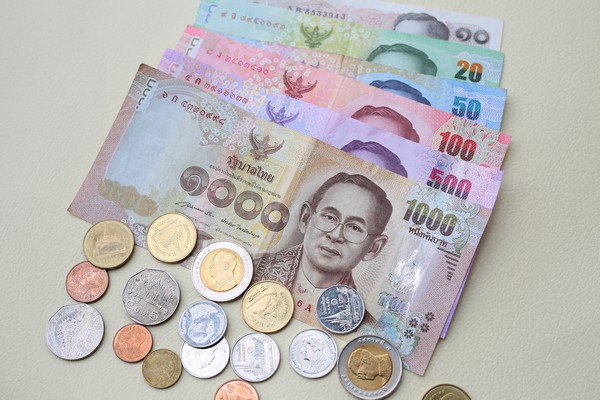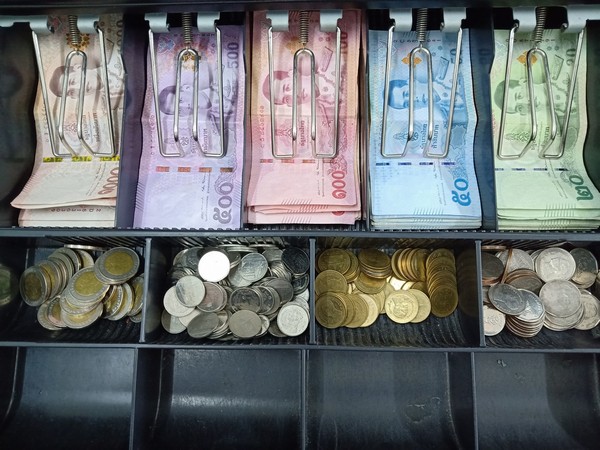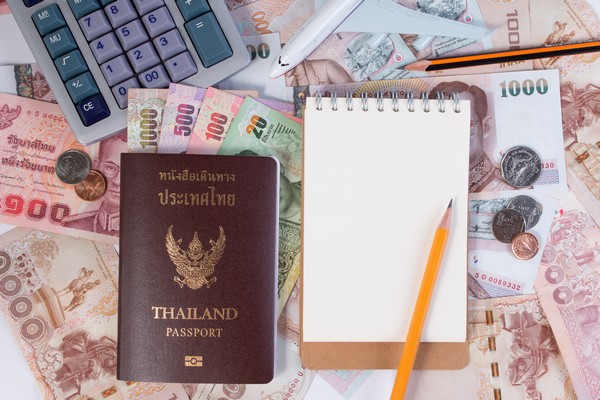
To travel abroad whether with the touring or business trip. Regularly, you need to exchange your cash for the local currency of the destination country. And for Thailand, Thai Baht is the currency of this country.
Thai Baht is the currency of Thailand. Formerly, the word “Baht” used to be one of the measurement units of Thai and there is some use of this word in the term of measuring, in particular, the gold trade. For example, the rate of gold trade today is THB15,000 / 1 Baht unit of gold. Initially, the 1 Baht coin that used at the beginning made from genuine 1 Baht of silver which is not a nickel in nowadays.
Thai Baht coin produced by The Bureau of Royal Thai Mint, which is a sub-division of the Treasury Department, the Ministry of Finance. The office can produce the coins unlimited without any guarantee fund because the raw material is the valuable metal by itself. Whereas, the banknote must produce and inspect for its circulation under the authorizing of the Bank of Thailand. To create the bill depends on the proper criteria to maintain the stability of the country.
According to the record of The Society for Worldwide Interbank Financial Telecommunication (SWIFT), Thai Baht is the 10th of the world currency which is one of the most frequently used currencies in World Payments.
Thai Baht, the current currency of Thailand, is subdivided into 100 satangs and debuted in 1897 in King Rama 5 era. Thai Baht consists of coins and banknote. Furthermore, there is another instrument to be used as the currency which is money card and cheque.
Thai Baht Notes and Coins

1. Coins
It is a small change that rotates in the daily life so that it is called “Circulated coins”. It made from low-cost metal, i.e. tin, Zinc, brass, and nickel and comprised 25 satangs, 50 satangs, 1 Baht, 5 Baht, and 10 Baht respectively. The low price one made from single metal and the 5 Baht coin upwards made from two kinds of the metal to prevent from the counterfeit. Thai circulated coins valued the price according to the value of any metal to produce the coins and also rated by the size of them. The amount of the coins will be imprinted on the coins.
As Thailand is the country in the democratic form of government with the King as Head of State and Buddhism is the religion of the nation. Customary, the image of the king included to the royal title will be presented on every circulated coin at the front. And the back side is the Thai architectures which perform to the Buddhism. Therefore, we can see many of Thai buildings from the north through the south of Thailand appear backward of the coins. That is to say, the introduction of Thai architecture and religion to show that Thailand is a kingdom that praises the Buddhism as the religion of the nation.
Thai government give the authorised to produce the circulated coins to the Bureau of Royal Thai Mint, the Ministry of Finance to take responsibility to specify the rate, type of the metal, design, manufacturing quality, and distribution.
2. Banknote
It is a high-value currency which made from speciality paper that is more durable than other material, i.e. Polymer. Thai Baht banknote namely 10 Baht in brown, 20 Baht in green, 50 Baht in blue, 100 Baht in red, 500 Baht in purple, and 1,000 Baht in Auburn. To differentiate size and color of the paper bill based on the value is to facilitate to the user to notice the price of the banknote quickly even in case of the blind that can notify the type of the bill by its length.
Traditionally, to design the paper bill in front of the bank shall print the present king’s portrait as the main component only. And it can be either the king’s portrait or the past king’s monument at the back. Also, there is the illustration to show to the royal-initiated projects or the royal duties. So that, the design shall consider the legitimate and beliefs of Thais. For example, the idea of the king is divine right which refers to the Vishnu descends from the heaven and rides on the Garuda. The paper money manufacturing is the authorize of the Ministry of Finance, as well. Nonetheless, it appoints to the Bank of Thailand to operate according to the Currency Act.
3. Money Card
It is the object to be used as the currency. It is a card of which identify the holder name and code and issued by the financial institution with the monetary amount as the agreement. The card can use for the money to pay for any goods and services. The payment by card must be at once, and the whole amount with the note of the items and the payee needs to sign the name to certify the debt on that document. And the payee gives the referent document to the retailers and the payment will recall paying after that. The money cards facilitate to the holders not to carry on the significant amount of cash and offer more opportunity to shop. Thus, the money card provides both merchants and tourists to be more convenient and secured.
The government permits the financial institutes to issue the money card or also called “credit card” to their clients. However, it is the complementary responsivity between the financial institute and the cardholder for any transaction. The economic presently, accepts that “credit card” can be used as the currency, so it could say that the credit card is similar a kind of the money, nonetheless its liquidity is lesser than the common currency because it may be rejected by the vendor and also it is not used widely.
4. Cheque
It is a liquidated document that made for the client to pay for the debt. The commercial banks pay in advance and charge from the clients after then. Every single cheque needs to identify the name of the commercial bank that issue it included issued date, receiver’s name, number of the amount, and payee’s name. The cheque has the property similar to the money card so that it is acceptable in the economic system to be used as a currency. However, it can be rejected by the receiver thus use of cheque is not liquidated as same as the traditional currency.
Thai Baht is a currency which used in general in Thailand to buy goods and services. Thai government determines the rules and regulations in currency trading with the money of other countries to limit the speculation in the currency.
Carry Money to Thailand

Individual / Tourist can carry any money in Thai Baht or foreign exchanges or negotiable monetary instruments into or off the Kingdom of Thailand basis to the legal without any ask for permission from the Bank of Thailand as by following;
Thai Baht (Thai currency)
Individual/tourist travelling to other countries are allowed to take out the money up to THB50,000 per person. An individual going to Thailand’s bordering countries – Cambodia, Laos, Myanmar, Malaysia, Vietnam, and Yunnan province of the People’s Republic of China is allowed to take out up to THB2,000,000 per time. And the amount exceeding 450,000 Baht or USD 15,000 or its equivalent must declare to a customs officer.
Any person would like to take out the Thai bank notes from the Kingdom of Thailand in amount exceeded from limitation, it is prohibited to ask for an authorise from the Bank of Thailand, and the individual must declare the authorised reference to a customs officer at the international airport upon the departure.
There is no limit on the amount of Thai baht bank notes that may bring into the country for any individual/tourist.
Foreign Exchanges
Any individual/tourist can transfer or bring in the foreign currencies to Thailand either bank notes or coins without any limit. However, any currencies in the amount exceeding US$20,000 or its equivalent must declare to a customs officer. Without the declaration, it is the misdemeanor.
What the foreign tourists pay when travelling in Thailand
Now, we will show you what the overseas tourists pay when taking a journey to Thailand. According to a survey of the Ministry of Tourism and Sports in purchasing behavior of the foreign tourist in 2016 categorized by the type of expense concluded the category of payment as by following;
Shopping:
The top spender among the tourists in shopping is the tourists from South Asia (India) with the average expense in amount US$56.6 or THB1,800 per day/head. And one of the reasons is the shop for resell in their country.
Entertainment:
The top spender of the entertainment activities during the trip to Thailand is the tourists from the Oceania or Australia Zone with the amount US$23.0 0r THB700++ per day.
Sightseeing:
The top spender in touring package in Thailand is, of course, the tourists from China. The cost for tour package per day is about US$9.5 or THB300 per day. This also showed that the Chinese tourists are a group that favour to take a trip to Thailand through the tour agent. However, the number of Chinese visitors to travel with the touring package tends to be increased continually; instead, they would take a journey on their own.
Accommodation:
It considers the major expense for travelling which is about 30% estimate of daily payment for the trip. The top spender of the accommodation expense is the visitors from Oceania with the fee per day in amount US$53.5 or THB1,700 on average. The lowest amount per day is US$26 or THB800. Therefore, the average cost of the accommodation is approximately between THB1,600-3,400 / room / 2 persons.
Food & Beverage:
It quite resembles the food and beverage cost for any group of the foreigners. Anyhow, the top spender in this category is the Oceania tourist in the amount at US$31.9 or THB1,000 per day followed by the Chinese at US$31.5.
Local Transportation:
The top spender who pays for the transportation during the trip in Thailand is American visitors at US$16.5 or THB500 per day which is not far from the second-ranked Chinese at US$16.1 per day.
Anyhow, the overall expense for the trip to Thailand, Chinese is the top spender among the overseas tourists in Thailand with the cost per day for each person in amount US$171.2 or THB5,500 on average.









